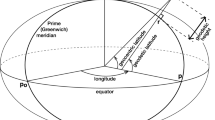Abstract
Effective communication regarding distance in the vertical dimension is critical for many ecological, climatological and broader geophysical studies of the Earth. Confusion exists regarding the definition of three English words commonly used to describe the vertical dimension: (1) elevation; (2) altitude; and (3) height. While used interchangeably in “everyday” non-technical English, here we provide explicit definitions and strongly recommend their use in scientific literature. We briefly discuss the likely origins of the sub-optimal use of these three words due to translations between languages. Finally, we provide examples of how using these terms, as explicitly defined herein, improves scientific communication.
Similar content being viewed by others
References
Bonin A, Taberlet P, Miaud C, Pompanon F (2006) Explorative genome scan to detect candidate loci for adaptation along a gradient of altitude in the common frog (Rana temporaria). Mol Biol Evol 23:773–783
Bryant JA, Lamanna C, Morlon H, Kerkhoff AJ, Enquist BJ, Green JL (2008) Microbes on mountainsides: contrasting elevational patterns of bacterial and plant diversity. Proc Nat Acad Sci USA 105:11505–11511
Choler P, Michalet R, Callaway RM (2001) Facilitation and competition on gradients in alpine plant communities. Ecology 82:3295–3308
Colwell RK, Brehm G, Cardelus CL, Gilman AC, Longino JT (2008) Global warming, elevational range shifts, and lowland biotic attrition in the wet tropics. Science 322:258–261
Daly C (2006) Guidelines for assessing the suitability of spatial climate data sets. Int J Climatol 26:707–721
Elith J, Burgman MA (2003) Habitat models for population viability analysis. In: Brigham CA, Schwartz MW (eds) Population viability in plants: conservation, management and modeling of rare plants. Springer, New York, pp 203–235
Ghalambor CK, Huey RB, Martin PR, Tewksbury JJ, Wang G (2006) Are mountain passes higher in the tropics? Janzen’s hypothesis revisited. Integr Comp Biol 46:5–17
Guisan A, Zimmermann NE (2000) Predictive habitat distribution models in ecology. Ecol Model 135:147–186
Guisan A et al (2006) Making better biogeographical predictions of species’ distributions. J Appl Ecol 43:386–392
Inouye DW, Barr B, Armitage KB, Inouye BD (2000) Climate change is affecting altitudinal migrants and hibernating species. Proc Nat Acad Sci USA 97:1630–1633
Kitayama K (1992) An altitudinal transect study of the vegetation on Mount Kinabalu, Borneo. Vegetatio 102:149–171
Körner C (2007) The use of ‘altitude’ in ecological research. Trends Ecol Evol 22:569–574
McBratney AB, Santos MLM, Minasny B (2003) On digital soil mapping. Geoderma 117:3–52
McKenzie NJ, Ryan PJ (1999) Spatial prediction of soil properties using environmental correlation. Geoderma 89:67–94
McVicar TR, Van Niel TG, Li L, Hutchinson MF, Mu X, Liu Z (2007) Spatially distributing monthly reference evapotranspiration and pan evaporation considering topographic influences. J Hydrol 338:196–220
McVicar TR et al (2010a) Parsimoniously modelling perennial vegetation suitability and identifying priority areas to support China’s re-vegetation program in the Loess Plateau: matching model complexity to data availability. For Ecol Manage 259:1277–1290
McVicar TR, Van Niel TG, Roderick ML, Li LT, Mo XG, Zimmermann NE, Schmatz DR (2010b) Observational evidence from two mountainous regions that near-surface wind speeds are declining more rapidly at higher elevations than lower elevations: 1960–2006. Geophys Res Lett 37:L06402. doi:10.1029/2009GL042255
Moore ID, Grayson RB, Ladson AR (1991) Digital terrain modeling—a review of hydrological, geomorphological, and biological applications. Hydrol Process 5:3–30
Moritz C, Patton JL, Conroy CJ, Parra JL, White GC, Beissinger SR (2008) Impact of a century of climate change on small-mammal communities in Yosemite National Park, USA. Science 322:261–264
Nogués-Bravo D, Araujo MB, Romdal T, Rahbek C (2008) Scale effects and human impact on the elevational species richness gradients. Nature 453:U216–U218
Turner MG, Romme WH (1994) Landscape dynamics in crown fire ecosystems. Landsc Ecol 9:59–77
Western AW, Grayson RB, Bloschl G, Willgoose GR, McMahon TA (1999) Observed spatial organization of soil moisture and its relation to terrain indices. Water Resour Res 35:797–810
Wilson JP, Gallant JC (2000) Secondary topographic attributes. In: Wilson JP, Gallant JC (eds) Terrain Analysis. John Wiley & Sons, Inc., New York, pp 87–131
Wilson RJ, Gutierrez D, Gutierrez J, Monserrat VJ (2007) An elevational shift in butterfly species richness and composition accompanying recent climate change. Glob Change Biol 13:1873–1887
Acknowledgments
We thank the many scientists listed in Table S1 of the ESM who provided translations for this comment. A note by Hal Mooney, Stanford University, to C.K. encouraged us to address this issue.
Author information
Authors and Affiliations
Corresponding author
Additional information
Communicated by Russell Monson.
Electronic supplementary material
Below is the link to the electronic supplementary material.
Rights and permissions
About this article
Cite this article
McVicar, T.R., Körner, C. On the use of elevation, altitude, and height in the ecological and climatological literature. Oecologia 171, 335–337 (2013). https://doi.org/10.1007/s00442-012-2416-7
Received:
Accepted:
Published:
Issue Date:
DOI: https://doi.org/10.1007/s00442-012-2416-7




